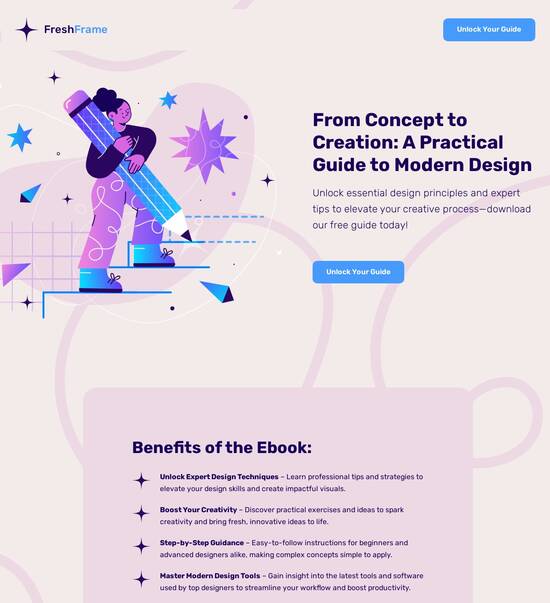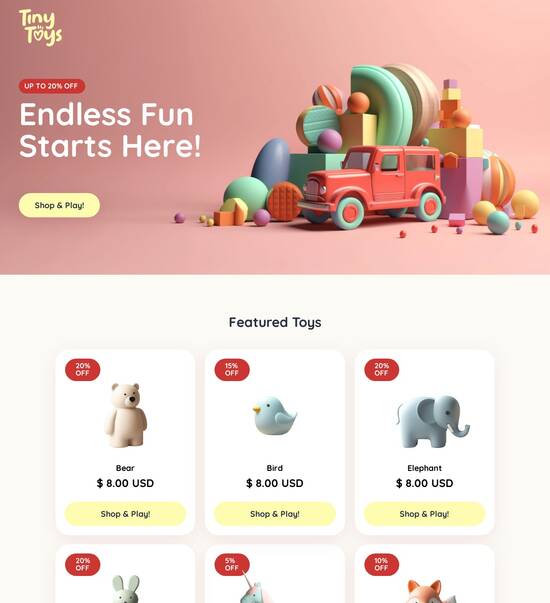
React.js optimized trading page template
Explore Similar TemplatesAbout template
Supercharge your trading page with React.js for outstanding performance! Learn more today.
Recommended templates

Easy to build without coding
With the intuitive drag-and-drop builder, anyone on your team can create high-converting pages without any knowledge of code or design. Make enhancements to your landing page with custom widgets using Javascript, HTML/CSS, or third-party scripts.

Multiple layouts for any industry and goal
Select from 500+ landing page layouts built to boost conversions across industry-specific scenarios. Customize them by adjusting fonts, adding images, and generating on-brand content with the AI assistant. Quickly scale with Instablocks® and Global Blocks that you can save, reuse, and update globally.

Loads fast and looks polished on any device
Every template is responsive, which means they present professionally on any device and load blazingly fast with our Thor Render Engine. You can also power them up with Google AMP technology to deliver an unparalleled mobile experience and drive higher conversions.

Robust analytics & experimentation
Get real-time updates and reporting across all your devices, showing the number of visitors, conversions, cost-per-visitor, and cost-per-lead. Launch AI-powered experiments, run A/B tests, and use heatmaps to analyze user behavior, then optimize your landing page to maximize conversions.







Easy to build without coding
With the intuitive drag-and-drop builder, anyone on your team can create high-converting pages without any knowledge of code or design. Make enhancements to your landing page with custom widgets using Javascript, HTML/CSS, or third-party scripts.
Multiple layouts for any industry and goal
Select from 500+ landing page layouts built to boost conversions across industry-specific scenarios. Customize them by adjusting fonts, adding images, and generating on-brand content with the AI assistant. Quickly scale with Instablocks® and Global Blocks that you can save, reuse, and update globally.
Loads fast and looks polished on any device
Every template is responsive, which means they present professionally on any device and load blazingly fast with our Thor Render Engine.
Robust analytics & experimentation
Get real-time updates and reporting across all your devices, showing the number of visitors, conversions, cost-per-visitor, and cost-per-lead. Launch AI-powered experiments, run A/B tests, and use heatmaps to analyze user behavior, then optimize your landing page to maximize conversions.
All the features you need to build lead-generating landing pages
Explore more featuresLearn how to build top-performing landing pages for any goal
FAQs
Leading the way in building high-performing landing pages





The power of Instapage for optimizing your landing pages
When it comes to crafting effective marketing campaigns, landing pages play a critical role. Instapage stands out as an all-in-one landing page and CRO (conversion rate optimization) platform, providing marketers with the essential tools to enhance their digital initiatives. With Instapage, creating high-converting landing pages can be easily achieved, whether for Business Services, Marketing and Advertising, Tech/SaaS, Education, Energy & Utilities, Financial Services, Government, or Insurance sectors.
Understanding the essentials of landing page optimization
Creating an appealing landing page involves several key components that contribute to user engagement and conversions. Here are some fundamental aspects to consider:
- Strong headlines: Capture attention immediately with impactful headlines that address the audience's needs.
- Compelling CTAs: Develop clear and persuasive call-to-action buttons that drive users to complete desired actions, such as signing up or making a purchase.
- High-quality images: Utilize visuals that resonate with your target audience, helping to communicate your message effectively.
Step 1: Choosing the right template
Start with a pre-built template that aligns with your campaign goals. Instapage offers over 100 ready-to-use, conversion-focused templates designed to meet various industry standards, allowing you to save time and resources.
Step 2: Personalizing your landing page
Once you select the template, customize it to reflect your brand's voice. Use dynamic text replacement to tailor content to the specific audience segments you’re targeting, enhancing engagement.
- Adjust color schemes: Match colors to your brand’s style guide.
- Modify images: Select images that appeal to the specific demographic.
- Refine text: Rewrite copy to address pain points relevant to your audience.
Step 3: Implementing optimization techniques
To ensure optimal performance, leverage built-in experimentation features within Instapage. Conduct A/B testing to determine which elements resonate most with visitors, enhancing conversion rates.
- Heatmaps: Analyze user interaction on the page and identify which elements attract the most attention.
- A/B testing: Test different headlines, CTAs or layouts to find the most effective combination.
- Analytics: Adjust your strategy based on performance metrics displayed in your dashboard.
By effectively integrating these steps, marketers can maximize the ROI of their digital campaigns using Instapage.
Start boosting your marketing outcomes today with Instapage — the ultimate platform for creating and optimizing high-performing landing pages.
ReactJS optimized trading page template
Understanding ReactJS: The foundation of dynamic trading pages
ReactJS has transformed the landscape of web development by introducing a new framework for creating user interfaces. Traditionally, web development relied heavily on monolithic structures, but as applications grew more complex, developers required a more efficient solution. This is where React comes into play, allowing developers to build web applications that are not only fast but also easy to maintain.
Since its introduction by Facebook in 2013, React has gained remarkable traction due to its ability to simplify the creation of fluid and interactive user experiences. With a focus on components, React allows developers to break down complex interfaces into smaller, reusable parts. This modular approach not only enhances productivity but also fosters a collaborative development environment, making it the go-to choice for modern web applications.
React is lightweight and efficient, focusing on performance.
The declarative syntax makes it easier to understand and predict application states.
The rich ecosystem of libraries and tools extends its capabilities considerably.
Key characteristics of a ReactJS optimized trading page template
Designing a trading page template using ReactJS entails incorporating specific features vital for traders. The structure starts with essential components such as headers, market overviews, and trading dashboards. Each of these components should provide a seamless experience and quick access to critical data for informed trading decisions.
A well-designed header component integrates the branding and navigation menu effectively, ensuring users can navigate effortlessly. Following that, the market overview section offers real-time updates on stock performances, alongside customizable widgets that reflect key metrics based on user preferences. Collectively, these essential components create a robust foundation for any trading page.
Header Component
Includes branding and easy navigation.
Market Overview Section
Displays real-time stock information.
Trading Dashboard Components
Features interactive charts and order management.
Deep dive into template architecture
The architecture of a ReactJS optimized trading page template is structured for modular design. This means that components are purpose-built and can be combined to create complex layouts without compromising performance. Each component operates independently, communicating through props or state management, which allows for dynamic rendering of the user interface.
Moreover, developers can implement advanced styling using CSS-in-JS libraries such as Styled-components. This approach enhances the maintainability of styles as they are encapsulated within their respective components, making updates and theme adjustments simpler and more efficient.
Component Communication
Utilizes props and state for dynamic interaction.
Modular Structure
Allows for independent component management.
CSS-in-JS
Facilitates easier styling and theming.
Performance optimization techniques in React trading templates
Performance is crucial in a trading application, given that users rely on real-time data to make decisions. Implementing best practices for efficient rendering can drastically improve the user experience. Techniques such as lazy loading of components can help reduce the initial load time, allowing essential elements to be available to the users without delay.
Furthermore, utilizing memoization methods like React.memo and the useMemo hook can prevent unnecessary re-renders, ensuring faster operation. By effectively minimizing the number of renders, developers can help maintain a fluid experience despite the heavy demands of data processing in trading applications.
Lazy loading components
Improves speed by loading components as needed.
Memoization techniques
Reduces re-renders for enhanced performance.
Code-splitting strategies
Utilizes React.lazy and Suspense for better load dynamics.
Leveraging React for scalable trading solutions
Scalability is a key consideration when developing trading pages, as user interactions can generate vast amounts of data. Effective design involves creating components that can accommodate varying data loads without compromising performance. This calls for a well-thought-out data management strategy, using tools like Redux or MobX to manage the state efficiently.
React's thriving community also contributes significantly to its ecosystem, providing a wealth of libraries and resources that can enhance trading page functionalities. With open-source contributions on GitHub and numerous forums dedicated to trading technologies, developers can find numerous tools tailored for creating robust trading page templates.
State management solutions
Leverage libraries like Redux for efficient data handling.
Community Support
Access to numerous resources and tools.
Data management techniques
Utilizes efficient systems to handle fluctuating loads.
Enhanced user interaction features
Creating an engaging user experience goes beyond static displays. Modern trading pages should incorporate interactive elements that draw users in. This can be achieved by developing dynamic forms for account management, enabling users to make changes effortlessly, alongside adding alerts for market changes that can notify traders of opportunities.
Moreover, incorporating user feedback systems allows for continuous improvement of the trading application. Gathering insights from traders can provide invaluable direction for future updates, ensuring that the template evolves to meet users’ needs effectively.
Dynamic forms
Facilitate user account modifications seamlessly.
Market alerts
Keep users updated on important changes.
User feedback systems
Incorporate insights for ongoing enhancements.
Navigating security and compliance in trading applications
Security is paramount in trading applications given the sensitive nature of trading activities. Essential measures include implementing HTTPS to encrypt data transmissions and robust user authentication systems. These security protocols help to build user trust and protect their financial and personal information from unauthorized access.
Additionally, compliance with regulations such as GDPR and SEC guidelines is critical. By integrating compliance considerations into the design of trading templates, developers can facilitate adherence to rules, ensuring that the platform operates within legal standards.
Data encryption
Ensures user information is protected during transmission.
User authentication protocols
Establishes secure login procedures.
Regulatory compliance
Adheres to relevant trading regulations.
Future directions: The evolving landscape of React trading pages
Staying current with emerging technologies is key for developers of trading pages. The relevance of artificial intelligence and machine learning is rapidly increasing, providing advanced analytics and trading options. As these technologies mature, developers need to consider future-proofing their templates to leverage innovative solutions, such as blockchain, which could redefine transaction security and transparency.
Furthermore, incorporating user feedback into the development cycle can play a pivotal role in shaping the future iterations of trading templates. By actively engaging with users, developers can identify pain points and adapt their solutions accordingly, fostering a more user-oriented environment.
AI and machine learning
Enhancing analytics and trading efficiency.
Blockchain adoption
Improving transaction security through innovative solutions.
User-driven enhancements
Integrate feedback for meaningful updates.
Practical tips and best practices for developers
Getting started with building a ReactJS optimized trading page template requires the right tools and resources. Developers should set up a robust development environment using tools such as Node.js and npm for package management. This foundational setup allows for easy integration of various libraries needed for a comprehensive trading solution.
Moreover, avoiding common pitfalls is crucial to streamline the development process. Frequent issues such as overcomplicating components or neglecting performance optimizations can lead to inefficient applications. Instead, focus on creating simple, reusable components while conducting regular performance reviews to maintain optimal execution.
Development environment setup
Utilize Node.js and npm for ease of package management.
Focus on component simplicity
Encourage reusable designs for efficiency.
Conduct performance reviews
Ensure optimal functionality through regular checks.
Engaging the community: Sharing and collaborating on templates
Collaboration with the community can significantly enhance the development process. Platforms like GitHub serve as valuable resources for sharing code, contributing to open-source projects, and discovering existing templates that can be built upon. Active participation in developer forums also offers networking opportunities for learning from other developers' experiences.
Encouraging user contributions encourages a culture of shared improvement. By inviting feedback and code contributions, developers can ensure that their templates remain relevant and effective. Highlighting successes from collaborative efforts can inspire further contributions, creating a continuous feedback loop that benefits the entire trading application ecosystem.
Using GitHub for code sharing
Collaborate on projects and enhance template functionality.
Participate in developer forums
Build a network for support and knowledge sharing.
Invite user contributions
Foster collaboration for ongoing improvements.
Ready to skyrocket conversions?
Supercharge your ad campaigns with high-performing landing pages
Get started














